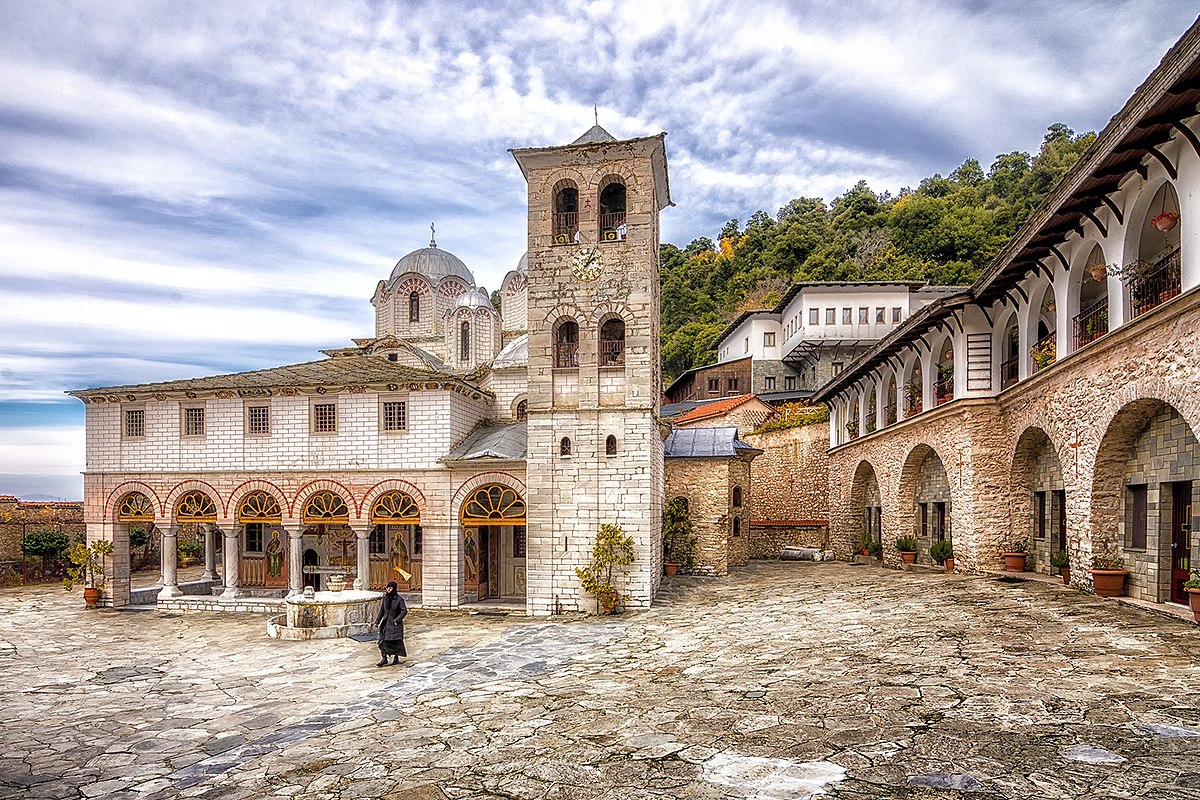The Virgin Mary Eikosifoinissa Holy Convent is located at the north side of the verdant Mount Pangaio.
It is one of the two holy places in Eastern Macedonia, Greece, which, till this day, is an attraction for many believers, who come to worship the “icon of the Virgin Mary” and to relax in its peaceful surroundings.
The name of the Monastery, according to one of the three versions, is due to the miracle of the icon of Virgin Mary, which shone and spread “phoenic” light, i.e. red, like the purple of the Phoenicians. This is where the name comes from: Eikon foinissoussa – Eikon – foinissa – Eikosifoinissa.
The main Monastery in the center has the imposing church of the Presentation of the Virgin and includes the Abbess, the cells of the nuns, the Archontariki, the chapel of Saint Barbara with the Holy Eucharist, the Museum, the Holy Bank, the workshops and related facilities, while the whole complex is surrounded by a high wall. In front of the Holy Monastery, there is a square and next to it, the monument of the 172 Monks who were massacred in 1507 by the Turks. Outside the outer wall is a marble shrine, next to that is another shrine with a dome, under which is a sanctuary. Then there is the Cemetery with the Naidrium of Agioi Anargyri. A majestic spire rises in the southeast corner of the temple. Outside and above the eastern walls of the Monastery, are the old windmill and the “stasidion tis Panagias” with a small pilgrim.
The Monastery, especially during the period of the Ottoman Greece, offered a lot for the preservation of Orthodoxy and Hellenism in Eastern Macedonia and Thrace. This action provoked the wrath, at first of the Turks and then of the Bulgarians. The monastery withstood their repeated destructive raids and brought forth a multitude of martyrs. According to information, the bishop, Philippos Sozon, who took part in the Fourth Ecumenical Synod, founded a church and a monastic settlement at Vigla, 50m. eastern of the current Monastery, where the surviving ruins of the wall and tower testify to the existence of an ancient large fortress. All this got abandoned later, when the first founder of the Monastery, Agios Germanos (518 AD), arrived here, who from a very young age became an eremite in the Holy Land. Since then and for several centuries, the story of the Eikosifinissa Monastery is completely unknown. Archaeological evidence lead to the conclusion that in the 11th century the “Catholic” part of the Monastery was rebuilt. During this period the Monastery became “stauropegial”, i.e. was directly dependent on the Ecumenical Patriarch.
The Monastery experienced a new glow in the year 1472, when the Ecumenical Patriarch Agios Dionysios, who is considered the second founder of the holy Monastery, retired to it after resigning his throne. During his long stay at the Monastery, he erected many new buildings and repaired old ones. During that period, the Monastery acquired great prosperity and glory. In the year 1507, 24 Hieromonks, 3 Hierodeacons and 145 Monks lived in the Monastery. They traversed through Eastern Macedonia and Thrace, strengthened the Christians in faith and prevented conversions to Islam. This action provoked the Turks, who on 25/08/1507 slaughtered all 172 monks. But they did not destroy the temple and the buildings.
The Monastery remained deserted and uninhabited for 13 years. After the massacre, the Ecumenical Patriarchate succeeded, in 1510, in obtaining permission from the Sultan for the reorganization of the Monastery. Thus, with the help of ten Monks of Mount Athos, in a period of ten years, 50 monks, deacons and hieromonks, who also had the governance of the Monastery, came to become monks at the Monastery. In the years that followed, the Monastery had become the spiritual and national center of Eastern Macedonia and Thrace, Greece. In this monastery, Emmanuel Papas came from Serres, sworn his hoplites and proclaimed the Revolution.
A famous Greek School operated in the Holy Monastery. The Library of Eikosifinissa was particularly noteworthy. Before its looting by the Bulgarians, in the year 1917, it contained 1300 volumes of books. Some manuscripts were of great archaeological value. During the centuries, those of the heyday, many buildings of the Monastery were repaired and erected. During the second half of the 19th century, it faced serious difficulties: in 1854 a fire burned the west side and part of the north, while in 1864 a cholera epidemic decimated the Monks. The proud archbishop Chrysostomos of Drama especially took care of the restoration of Eikosifonissa. At that time, not only the Turks were feared, but also the Bulgarians, who in 1917 stole the priceless religious treasures of the Monastery. During World War II, again the Bulgarians completed the destruction by setting fire and burning its buildings. The reconstruction of the Monastery really began in 1965 and within 15 years it managed to have its present appearance. In 1997 the Monastery numbered 25 Nuns. It celebrates on August 15 in memory of the Virgin Mary, on September 14 in memory of Holy Cross Virgin Mary Eikosifoinissa Holy Convent and on November 21 in memory of the Presentation of the Virgin.
Copyright 2023 © Created By Diadyktio, All Rights Reserved.
To provide the best experiences, we and our partners use technologies like cookies to store and/or access device information. Consenting to these technologies will allow us and our partners to process personal data such as browsing behavior or unique IDs on this site and show (non-) personalized ads. Not consenting or withdrawing consent, may adversely affect certain features and functions.
Click below to consent to the above or make granular choices. Your choices will be applied to this site only. You can change your settings at any time, including withdrawing your consent, by using the toggles on the Cookie Policy, or by clicking on the manage consent button at the bottom of the screen.

Congratulation!